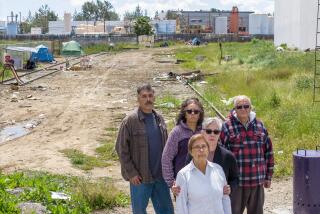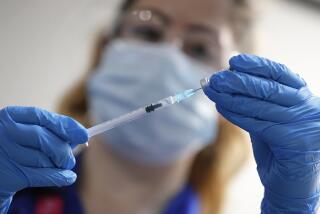Rockwell Denies It Has Shredded Test Site Records
- Share via
A dispute involving a health study of workers at the Santa Susana Field Laboratory west of Chatsworth on Wednesday prompted a Rockwell International official to angrily deny assertions that the company could destroy records pertinent to the study.
The bitter exchange came at a meeting in Simi Valley of the task force of government agencies involved in a cleanup of the test site in the Simi Hills, where Rockwell formerly did extensive nuclear research for the U.S. Department of Energy.
It followed disclosure of a simmering feud between a high-ranking Energy Department official and fellow members of an advisory panel that will oversee the health study, which is intended to determine if Rockwell workers have experienced unusual patterns of illness resulting from toxic or radioactive exposures.
The department official is Robert Goldsmith, director of epidemiology and health surveillance for the agency, which has pledged up to $840,000 for the 18-month study, for which a contractor has been tentatively selected.
Since adverse findings could cause problems for the Department of Energy, fellow committee members and state lawmakers involved in setting up the panel believed Goldsmith would be a non-voting member. But in a report to the task force Wednesday, Larry Bilick, staff member for the advisory committee, said Goldsmith objected to his non-voting status when the advisory panel met in September to consider proposals from five contractors competing to do the study.
In response, Bilick said, Goldsmith backed off an earlier promise to have a letter sent to Rockwell by Secretary of Energy James Watkins directing the firm to preserve all records that might be useful for the study.
Bilick said Goldsmith told him: “If I don’t have a vote, I’m not acting on the letter.”
Goldsmith did not return phone calls Wednesday. But a locally based Energy Department official who attended Wednesday’s meeting said he didn’t think Goldsmith should be a voting member. “I don’t want any blemish” on the study, said Roger Liddle, the department’s restoration project manager at Santa Susana.
The advisory panel asked Goldsmith for the letter after failing to secure a pledge from Rockwell that no records would be destroyed. In a Sept. 3 letter to Daniel Hirsch, an anti-nuclear activist and co-chairman of the advisory committee, Steve Lafflam, director of environmental protection for Rockwell’s Rocketdyne division, said the company “already has in existence a record retention policy,” but made no specific commitments.
When Lafflam said Wednesday that Rockwell does “not have any wholesale shredding going on,” Hirsch shot back: “Do you have any retail shredding?”
Rockwell, said Hirsch, essentially was reserving its right to destroy important documents--a charge Lafflam called an “absolute lie.”
The dispute remained unresolved Wednesday, and it’s unclear if it will affect the course of the health study. For one thing, officials said the Energy Department has already issued policy guidelines to contractors, including Rockwell, on preservation of records relating to workers’ health.
And, according to Lafflam, company officials have not “destroyed any records either before these . . . meetings or since.”
Moreover, with respect to Goldsmith, it’s uncertain if his vote will ever be decisive on a 13-member panel, which is currently negotiating with the contractor whose proposal was judged best.
But the controversy reflects a prevailing mood of rancor and distrust that always grips meetings like Wednesday’s, which was attended by more than 50 citizens and Rockwell and government agency representatives. Virtually all utterances by Rockwell officials come under attack because, as activist Laura Zinkan said, “nobody in this community is going to take their word for anything.”
In another matter Wednesday, Rockwell officials said if the weather holds they expect to meet a Dec. 31 deadline for cleaning up an old waste dump known as the sodium burn pit. The company is removing toxic and radioactive contamination from the burn pit as part of a $44-million cleanup of tainted soil, ground water and buildings within 290 acres of the field lab where nuclear work was performed for three decades.
Although company officials say soil and old equipment buried in the pit contain very low radioactivity, critics questioned why any nuclear contamination was found in an area not designed for those wastes.
“How could you possibly not catch that?” asked Hirsch, adding that other areas of radioactivity on the site may remain undiscovered.
“There was a breakdown in procedures,” Lafflam said. “We’ve admitted that, obviously, things got there” that shouldn’t have.
But he said, “I think we’re losing sight of the fact that we’re cleaning the site up.”
More to Read
Sign up for Essential California
The most important California stories and recommendations in your inbox every morning.
You may occasionally receive promotional content from the Los Angeles Times.










